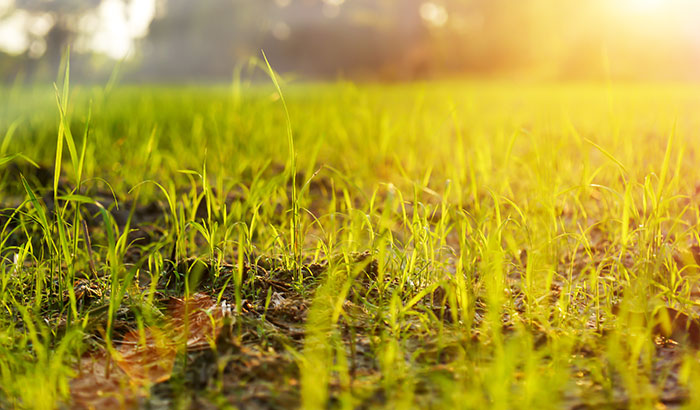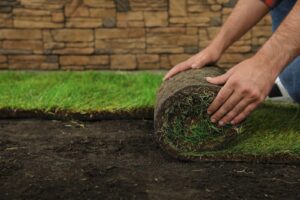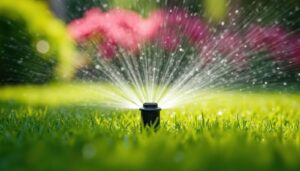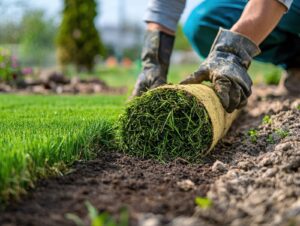A well-manicured lawn is a hallmark of a beautiful home, and fertilizing it is a critical aspect of lawn care that can’t be overlooked. If you’re looking to achieve a lawn that is the envy of your neighborhood, understanding the intricacies of fertilizing your lawn is essential.
Whether you’re an experienced gardener or a novice seeking guidance, this comprehensive guide will give you all the information you need about fertilizing your lawn.
The benefits of lawn fertilization are numerous and go beyond just aesthetics. By properly fertilizing your lawn, you can promote healthy growth, prevent weed and pest infestation, improve soil fertility, and enhance your outdoor space’s overall health and appearance.
However, with so many options and considerations, it’s natural to feel overwhelmed. Which fertilizer should you choose? When is the optimal time to fertilize? How should you apply fertilizer effectively? It’s common to have these questions.
In this guide, we’ll delve into the world of lawn fertilization, providing you with practical and valuable insights on the benefits of fertilization, understanding different types of fertilizers, optimal timing for application, proper application techniques, tips for fertilizing a new lawn, and additional best practices to ensure success.
Whether you’re an experienced gardener looking to refine your lawn care routine or a beginner seeking guidance, this guide is designed to help you make informed decisions and achieve a healthy and lush lawn.
Benefits of Lawn Fertilization
A lush, healthy lawn is the pride of any homeowner, and achieving that requires proper care and attention. Beyond aesthetics, fertilization offers a range of benefits that go beyond just a beautiful lawn. Here are some of the reasons you should be fertilizing your lawn:
- Promotes Healthy Growth: One of the primary benefits of lawn fertilization is that it supports healthy growth. Using a high-quality grass fertilizer with nitrogen, phosphorus, and potassium is crucial for properly developing grass.
These nutrients help to nourish the lawn, providing the necessary elements for photosynthesis, root growth, and overall plant health. Whether you’re fertilizing new sod or a lawn you’ve had for a while, you can expect a thick, lush, and vibrant lawn that becomes more resilient to environmental stressors and diseases as long as you fertilize correctly.
- Prevents Weed and Pest Infestation: A well-fertilized lawn is better equipped to fend off weeds and pests. When properly nourished, grass grows more vigorously, filling in gaps and leaving less room for weeds to take hold.
Additionally, some fertilizers contain herbicides that can prevent weed seeds from germinating, further reducing the chances of weed infestation. Moreover, a healthy lawn with strong roots can better withstand pest attacks and recover faster from any damage caused by pests.
- Improves Soil Health: Fertilization not only benefits the lawn but also improves the health of the soil. Over time, soil can become depleted of essential nutrients due to natural processes, weathering, or nutrient uptake by plants.
Fertilizers replenish these nutrients, enriching the soil and enhancing its fertility. Healthy soil is essential for the long-term health of the lawn, as it provides a favorable environment for root growth, nutrient uptake, and overall plant health. Improved soil health also promotes beneficial microbial activity, which aids in breaking down organic matter and releasing nutrients for the lawn.
- Enhances Overall Lawn Appearance: A well-fertilized lawn promotes healthy growth and enhances its overall appearance. A thick, lush, green lawn creates a visually appealing landscape that adds value to your property.
Fertilization can achieve a consistent color and texture throughout the lawn, making it look more uniform and aesthetically pleasing. A healthy lawn also recovers more quickly from stressors such as drought or foot traffic, maintaining its lush appearance even in challenging conditions.
Understanding Different Lawn Fertilizers
With so many options available, it’s essential to understand the different types of lawn fertilizers and their applications so you know what’s best for your lawn. You should look for a grass fertilizer with nitrogen, phosphorus, and potassium, the three main ingredients needed to promote healthy growth.
While practically all lawn fertilizers will have those ingredients, different types function differently. Here are the four main types of lawn fertilizers:
- Granular Fertilizers: Granular fertilizers are solid particles typically spread on the lawn using a spreader. They come in various formulations, such as quick-release, slow-release, balanced, and specialty fertilizers. Granular fertilizers are easy to apply and provide a slow and steady release of nutrients to the lawn, making them ideal for long-term feeding. They are also less likely to cause burn or leaching than quick-release fertilizers. Granular fertilizers are commonly used for general lawn maintenance and fertilizing new sod, providing sustained nutrition, and promoting overall lawn health.
- Liquid Fertilizers: Liquid fertilizers are liquid formulations typically mixed with water and applied to the lawn using a sprayer. Depending on the formulation, they come in various concentrations and can provide quick and slow-release nutrition to the lawn. The grass quickly absorbs liquid fertilizers, making them ideal for providing rapid results. They are also highly customizable, allowing for precise nutrient application and targeted feeding. Liquid fertilizers are commonly used for spot treatments, foliar feeding, and providing quick nutrient boosts to the lawn.
- Organic Fertilizers: Organic fertilizers are made from natural sources, such as animal manure, bone meal, or compost. They are typically slow-release and provide a range of essential nutrients to the lawn while improving soil health. Organic fertilizers are eco-friendly, as they are derived from renewable resources and are less likely to cause leaching or runoff. They are commonly used to promote long-term soil fertility, improve soil structure, and support lawn health.
- Synthetic Fertilizers: Synthetic fertilizers are manufactured using synthetic chemicals and are typically formulated with precise nutrient ratios. They provide a quick release of nutrients and can be tailored to specific lawn needs. Synthetic fertilizers are known for their convenience, ease of application, and ability to deliver rapid results.
However, they may also have some environmental concerns associated with their use, such as leaching and runoff. Synthetic fertilizers are commonly used for their quick action and precise nutrient delivery, making them ideal for addressing specific lawn care needs.
When deciding what type of fertilizer is best for your lawn, we recommend talking with a lawn care professional to see what they recommend for your unique situation.
When Is the Best Time to Fertilize Your Lawn?
Timing is crucial when it comes to fertilizing your lawn. Applying fertilizer at the right time ensures your lawn receives the nutrients it needs to thrive and grow. But when is the best time to fertilize your lawn?
Several factors influence the ideal timing for lawn fertilization. These factors include the type of grass in your lawn, the climate in your region, and the time of year. Warm-season grasses like Bermuda grass and St. Augustine grass have different nutrient needs and growth patterns than cool-season grasses, such as Kentucky bluegrass and fescue.
Additionally, the climate in your region, including temperature and precipitation patterns, can impact the timing of fertilization. Lastly, the time of year, whether spring, summer, fall, or winter, can also affect when to fertilize your lawn.
Generally, the best time to fertilize your lawn is during its active growth period.
This typically occurs during the late spring and summer months for warm-season grasses, when the grass is actively growing, and temperatures are consistently warm. For cool-season grasses, the ideal time for fertilization is during the fall and early spring, when the grass is in its peak growing season and recovering from winter dormancy.
If you live in Northern Utah, we recommend using a grass fertilizer with nitrogen, phosphorus, and potassium in early spring when the snow has melted.
It’s important to note that the specific timing may vary depending on your region’s climate, grass type, and other local factors. Again, we recommend talking with a local lawn care expert to determine the optimal timing for fertilizing your lawn.
How to Apply Fertilizer
Applying fertilizer correctly is crucial to ensure that your lawn receives the nutrients it needs without causing any harm. To apply fertilizer, start by carefully reading and following the instructions on the fertilizer package, as the application rates may vary depending on the type of fertilizer and your specific lawn’s needs.
Use a spreader to distribute the fertilizer evenly, overlapping each pass slightly to avoid streaks or uneven application. Water your lawn thoroughly after applying fertilizer to help the nutrients penetrate the soil and reach the roots of the grass.
Be sure to clean your equipment properly after use and follow any safety precautions the manufacturer provides. Correctly applying fertilizer will help your lawn receive the nutrients it needs for healthy growth and lush greenery.
Can You Over-Fertilize Your Lawn?
Over-fertilizing your lawn can have negative consequences. Applying too much fertilizer or applying it too frequently can result in burned or damaged grass, increased weed growth, and potential environmental harm. Following proper fertilization practices and avoiding over-fertilization is important to maintain a healthy and thriving lawn.
Fertilizing a New Lawn
Timing is crucial when fertilizing a new lawn with newly laid sod. It’s generally recommended to wait at least two to four weeks after laying sod before applying fertilizer. This allows the sod to establish its root system and prevents the risk of burning the sod with excessive nutrients. Be sure to follow the manufacturer’s instructions on the fertilizer package for the recommended application timing.
Upgrade Your Lawn with Monarch Sod
At Monarch Sod, we are dedicated to helping you achieve a picture-perfect lawn that will be the envy of your neighborhood. Our high-quality sod products and professional installation services are designed to provide you with a lush and healthy lawn that will enhance the beauty of your outdoor space.
Whether you are starting a new lawn or looking to revitalize your existing one, Monarch Sod is your trusted partner in lawn transformation in Utah County, Salt Lake County, and Davis County.
Call us today at 801-800-8058 to learn more about our products and services, and follow our blog, where we post everything you need to know about lawn care in Northern Utah. Whether you need tips on fertilizing new sod, how often you should water, or lawn cleanup tips, we’ve got you covered.
Invest in the beauty of your lawn with Monarch Sod, and enjoy the benefits of a lush and vibrant outdoor space for years to come!












